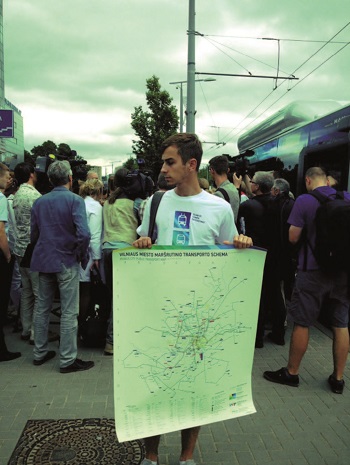Over the past decades, Vilnius has seen a vast decline in
public transport passengers. To reverse this trend the
municipality launched a public transport reform plan
including rapid bus routes and integration of operators.
The reforms seem to pay off: since July 2013 ticket sales
have gone up and the majority of passengers value the
network changes.
Since the 1980’s Vilnius has faced a major decrease of
public transport use, dropping from 87.6 % (1980) to
39.6 % in 2011. This significant downfall was caused by
a number of shortcomings of the local transport system,
such as:
1. An ineffective route network due to urban sprawl.
Vilnius has one of the lowest urban density rates in the
whole of Europe.
2. Neither a rapid transit network, nor rapid bus routes
were deployed.
3. Absence of an extended network of dedicated bus
lanes, nor a bus priority system in place.
4. Two separate ticketing systems in Vilnius, one municipal
and one for private operators.
Vilnius city decided recently to address these issues to
reverse the trend of decreasing ridership.
Over the course of five years, a number of studies have
been conducted and improvements were made in preparation
of a bigger PT reform. A dedicated plan for the
introduction of new modes of transport has been prepared
in collaboration with a number of partners including the
Vilnius Gediminas Technical University.
Routes were adjusted based on surveys and passenger flow
data. Citizens were encouraged to contribute to the
discussions on route changes and new timetables. Over
500 suggestions have been received of which one-third
could be taken in.
It was clear to the City of Vilnius that a package of activities
had to be implemented to improve the PT system in
the city and lead more people to use PT as their main
mode of transport. On 1 July 2013, a major reform was
implemented. The cornerstones of this reform are the
introduction of rapid bus routes and integration of
different operators.
1. Dedicated Bus Lanes and Rapid Bus Routes
The withdrawal of old single tickets allowed the optimisation
of the transport network. Since the PT network had
been reorganised in the way that passengers would have
to change buses more often (as compared to the PT
system before the optimisation) to reach their destination,
new 30-minute and 60-minute electronic tickets were
introduced allowing passengers to travel with one ticket
when transferring from one vehicle to another.
Moreover, Vilnius municipality realised that rapid bus
routes (RBRs) would not be successful without the creation
of dedicated bus lanes (DBLs). An additional 15 km of
DBLs were created in the city to reduce travel time. This
extended the total length of bus lanes in Vilnius to 35 km.
In addition, the number of stops was reduced significantly.
This led to the introduction of six rapid bus routes,
shortening the average travel time by 12.5 minutes. A
significant reduction compared to the average journey
time of 48.75 minutes before. The travel speed of the
rapid buses was raised by around 6.4 km/h, equalling
37% of the speed on RBRs.
The RBRs serve the central part of the city. This zone
covers approximately 75 per cent of all residential and
work places in the city. The speed of the vehicles is around
25 km/h and the buses run approximately every 4-6
minutes.
These top-level bus routes are supplemented with main
routes and suburb routes. The main routes serve the
central and the middle city zones. Buses and trolleybuses
operate in these areas with services running every 10-15
minutes.
The suburb routes serve the peripheral and suburban
zones of Vilnius and are operated by multi-capacity
buses. The frequency of these services corresponds with
the passenger flow.

2. Integration between different operators
The different ticketing systems of the municipal and the
private operator required duplicated routes to meet the
needs of ticket holders. Once an integrated electronic
ticketing system is implemented, the need to maintain
duplicate routes will vanish. The Mayor of Vilnius Arturas
Zuokas said that the elimination of duplicate services will
save the city some € 5.8 million a year. Savings that may
be used to finance further improvements of the PT system.
A total of € 1.02 million was invested on the measures for
PT reform. The DBLs made for the main share with about
€ 950 000, about € 62 000 was spent on communication
activities about the reform.
Results
The ticket revenues went up immediately after introduction
of the adjustments. In July 2013, € 3.13 million ticket
sales was accomplished, compared to € 2.62 million in July
2012. In addition, the number of trips rose from 11.51 million in
July 2012 to 14.44 million.
In a passenger survey monitoring the introduction of the
reform, 64% of respondents rated the changes in the PT
system as either neutral or positive, and 70% believed the
introduction of the rapid bus route service was necessary.
Challenges, opportunities and lessons
Vilnius was faced with a number of obstacles during the PT
reform process. Firstly, Vilnius municipality received criticism from users because of the expulsion of some
private operators.
The idea was to allow private operators that meet certain
standards into the Vilnius PT system. For that reason the
partnership agreement between the city and private
operators was not renewed. The disappearance of private
operators led to doubts about whether the Vilnius PT
company would be able to accommodate the growth of
ridership adequately all by it self.
Secondly, opposition from political counterparts caused
delay in the implementation process.
Vilnius has experienced that major reforms are likely to
generate opposition from many, especially because of
uncertainties to be resolved surrounding the implementation.
Nevertheless, Vilnius PT values the lesson that well
prepared changes are risks worth taking to bring about significant
improvements.
Contact: Justė Matonytė, Project Manager at Public Transport Department
